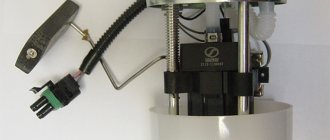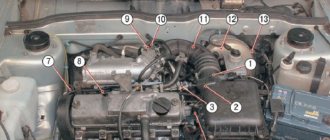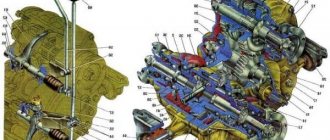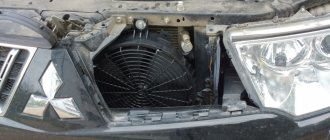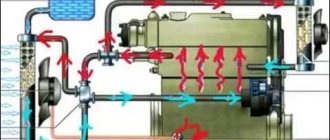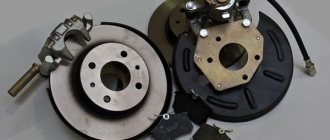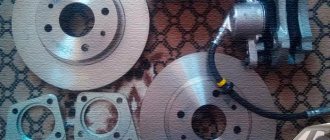VAZ-2109 is perhaps the most famous Russian-made car. This car has been produced since the times of the USSR. It was the first car where torque was transmitted to the front wheels rather than to the rear wheels. The car is very different in design from the usual “classics”. But is the exhaust system of the VAZ-2109 so different? The design, purpose and features of the system will be described later in the article.
Device
In total, this system includes several elements. This:
- An exhaust manifold. This is the very first part through which gases pass after combustion. People call the collector a spider for its characteristic shape. This element is supplied to each of the four cylinders of the internal combustion engine. Then all these pipes are combined into two, and then into one single pipe. There are also sports manifolds with a 4-2-1 exhaust pattern. They are installed to increase power. As practice shows, gases move more freely along the path, but the driver still will not feel a significant increase in power.
- Reception pipe. It connects to the collector. There is a special probe inside this pipe. This is an oxygen sensor, or lambda probe. If we talk about the VAZ-2109 exhaust system (carburetor), there is no such sensor in the system. But on car injectors, a lambda probe is required. The slightest problems with it may be accompanied by a “Check Engine” lamp on the instrument panel. In fact, the exhaust pipe has the simplest device. There are no sound-reflecting partitions or special fillers. This is an ordinary hollow pipe in which a single sensor can be located.
- Catalyst. As in the previous case, this element is present only on injection versions. There is no catalyst on carburetor engines. What is this element needed for? Its main task is to reduce the concentration of harmful substances in exhaust gases. Passing through the catalyst honeycomb, harmful metals are converted into harmless oxides. Thanks to the use of this element, the machine began to comply with the environmental standard Euro-2 and higher. The catalyst is the most expensive element in the VAZ-2109 exhaust system (injector). Therefore, when it malfunctions, many install flame arresters or simply knock out the core and weld the walls, leaving the catalyst empty inside.
- Resonator. This element is present on both carburetor and injection versions. A resonator is installed behind the catalyst. What is his task? The resonator serves to absorb the main noise from the exhaust gases. Thanks to this element, the sound of gases becomes less. The resonator is designed simply. This is a metal case with a perforated pipe inside. Additionally, there may be a partition inside.
- Main muffler. The resonator can be called an auxiliary muffler, but the main sound energy is absorbed by the last muffler, located under the rear bumper. It enters the resonator and absorbs up to 90 percent of the sound. The structure of this element is somewhat more complicated. The basis here is also taken from perforated tubes, but there are several of them, as well as chambers. Usually these are three or four tubes and two chambers. Passing through this entire labyrinth, the gases lose their energy and exit without unnecessary sound.
What is required to build an ASG (direct-flow exhaust system): tuning kit
Undoubtedly, installing a PG is a tuning, a modernization. And everything you need to build such a sporty exhaust option is available in stores.
The first is the resonator. Note that the sports PG does not have partitions that prevent the escape of gases. Its entire design is aimed only at ridding the internal combustion engine of excess gases generated during fuel combustion. As a result, power increases due to increased airflow.
Interesting point. On cars equipped with a naturally aspirated internal combustion engine, installing a sports PG allows you to increase power by 10 percent of the standard power, and on turbocharged cars - by 20 percent or even more.
The second necessary element, of course, is a new direct-flow flame arrester. The universal damper is intended as an alternative to the standard catalyst when constructing a direct flow. Such an element must be made of stainless steel (there is an option of aluminized steel). The internal part of such a flame arrester has a universal design, designed to increase the power of the machine’s power unit.
The structure of the muffler in the form of a diagram gives a complete picture of it
Fastening elements and other accessories, which must include various adapters, adapters, flanges, thermal tape for the exhaust manifold, etc., are also part of the system.
And finally, the muffler pipe, made of stainless steel or aluminized. The pipe itself must have an increased diameter (usually in the range of 38–76 mm). The length of the pipe is about 1000 mm, the wall thickness is 1.5 mm.
Malfunctions
Due to its simple design, this system is very reliable and rarely requires attention. But nothing lasts forever, so over the years the muffler and other elements burn out. Most often, it is the muffler that fails, as it takes the entire blow. It can burn out both outside and inside. In the latter case, the breakdown can be determined by the loud exhaust sound. Driving with such a muffler is not dangerous, but not very comfortable. Firstly, sound insulation suffers, and secondly, gases can break into the cabin. Therefore, it is better to replace this element immediately, given that it costs a penny.
Additional Information
The desired result was achieved thanks to a whole range of measures affecting literally all elements of the car: the camshaft, combustion chambers, inlet and outlet manifolds, gas exhaust paths (their shape, length and location) and mufflers. And the solid, bass sound of the running engine was only a concomitant factor of the real direct-flow exhaust system. In fact, the purpose of creating such a device was to maximize the use of engine power and reduce its losses during engine operation.
And they achieved this, as already mentioned, with a whole set of measures that are impossible for an ordinary user to implement in a garage. So there is no need to create illusions that by acquiring a muffler that is in some way different from the standard one, you have significantly increased engine power and improved the dynamics of the car. The result of all such work will be, at best, a change in the sound of its exhaust. Although if this is your goal, then you will achieve the desired result.
A direct-flow muffler, or as it is usually called, a forward-flow muffler, when installed on a production car, is designed to change the sound of a running engine. The reasons why this is done may vary from person to person. But you should be aware that there are certain standards for the level of sound pressure permissible for a car, above which the vehicle is not allowed to operate. And also that significant noise from a running engine causes concern to others and neighbors.
About repairs
Some owners resort to muffler repair. But it must be said that such measures, if not useless, are at least temporary. The fact is that gases can break through not only outside the muffler, but also inside. That is, after installing the patch, the exhaust sound will not change. The cost of a new muffler for a “nine” is now about a thousand rubles. And it will last much longer than the old repaired one.
The difference between a direct-flow muffler and a conventional one
A straight-through muffler is the same muffler, but without baffles to dampen low-frequency noise. It may contain mineral wool padding, which dampens high-frequency noise but allows low-frequency noise to pass through.
A standard muffler consists of a rather complex system of pipes and grilles in which noise is dampened. Parts of the exhaust system on a modern car also include a lambda probe, a catalytic converter, and an exhaust gas temperature sensor. Thus, a standard muffler compared to a forward flow muffler is a slightly more complex system.
The standard muffler consists of a complex system of pipes and grilles
Direct-flow muffler device
For proper tuning of the exhaust system, it is advisable to install a different, improved exhaust manifold in combination with forward flow, remove the catalyst and install a receiving pipe of increased diameter. After all, in a tuned exhaust system, all obstacles that stand in the way of exhaust gases have been removed.
A straight-through muffler is made so that its throughput is higher than that of a standard muffler, and it more freely removes exhaust gases from the engine. As a result of such tuning, cylinder purging improves, less carbon deposits on the pistons and valves, which, in turn, increases the life of the power unit. Its power increases by about 15%.
A related factor is a slight deterioration in noise performance compared to the standard muffler. The straight-through muffler has a harsh roar that can attract the attention of the traffic police, cause a fine, or provoke the anger of neighbors when a tuned car revs under their windows early in the morning.
When installing an improved exhaust system, these factors should also be taken into account, otherwise tuning may cause pointless costs in the future. The absence of internal partitions and noise-absorbing padding makes direct flow relatively simple to manufacture.
What does direct flow give?
A significant improvement in the power performance of a car with the installation of a direct-flow muffler occurs when the power unit is fully operational, maintains normal compression, is little worn, and even better - if any of its components have been modified. Thus, forward flow will increase power if the cylinder head, the intake system have been tuned, or the cylinder block itself has been bored to a larger volume. If the car owner has not yet taken on serious modifications to the engine, but wants to spend money on exhaust tuning, then by doing so he will still increase the power of the power unit, receiving in addition a bass rumble, making the car a little more dynamic.
The filling of the cylinders with the air-fuel mixture depends on the nature of the exhaust gases. However, changing the sound in a “sporty” direction is sometimes enough for a car enthusiast, as it gives the car a certain style. It is worth moving on to any change in the design of a car with the utmost seriousness, since all systems and assemblies in it are interconnected. If you do not properly modify the exhaust system, you can end up with a very roaring car, the ride in which will become unbearable for both the driver and passengers.
How to replace?
Based on the above, we can conclude that the best muffler repair is to replace it. This statement is also relevant for other parts of the VAZ-2109 exhaust system. The muffler is replaced with an inspection hole, a 13mm spanner and a socket of the same size. All actions are performed step by step:
- The car is driven into the inspection hole and put into gear.
- The main muffler is disconnected from the resonator. To do this you need to find a clamp. Use a spanner to tighten the fastening nut (to prevent twisting). At this time, the bolt is unscrewed with a ratchet.
- Afterwards, the fasteners are removed and the elements of the exhaust system are disconnected. The clamp is reusable, so we will put it back.
- Carefully remove the front part of the muffler from the rubber “cushion”, through which the part is attached to the body. Then the same operation is done with the front “pillows”.
- If the muffler is stuck to the resonator pipe, it can be rotated counterclockwise and back. This makes it easier to remove the muffler.
- The new element is installed in the reverse order.
Please note that rubber pads may be torn. It's better to buy a spare set. On the “nines” they are very flimsy. It is advisable to install pillows made of durable material (for example, polyurethane). This will not affect comfort (there will be no more vibrations), but the resource is at least twice as long.
How to make a straight-through muffler quieter
The PG becomes quieter as it is collected. And each craftsman does this differently, using mineral wool, metal shavings, brushes or asbestos. It is also recommended to arrange several compartments inside the homemade muffler, creating additional resonance.
The installation of direct flow in various ways involves the use of mineral wool, shavings and other fillers
A car with an exhaust louder than 96 dB does not pass inspection, does not cross the border, and does not drive around the city. This is the law. Sound today is limited even in motorsport, where it would seem there should be no restrictions or boundaries.
Having decided to suppress the GHG, you need to understand that this should in no way affect the effectiveness of the new system. None of the components of the GHG system should create resistance to exhaust gases.
Flute
The flute or silencer in the PG is a simplified design used by tuners. Its task is to “calm down” the SG, obtaining legitimate dB at the output.
Making a flute is not difficult. It will be enough to use as a muffler a piece of a perforated 20-centimeter tube with a diameter that is slightly larger than the exhaust (by 1/3). A disk or conical washer must be fixed to the pipe to act as a plug. Fastening is carried out using bolts at the air cut. The washer, in fact, creates a structure that resembles a flute.
The flute is used in PG to reduce noise
The cost of ready-made silencers in stores varies from $8 to $150. Chinese models are very cheap, but don’t expect quality from them. Original, good European-made flutes can be purchased for $100–$150.
You can assemble a flute for the PG yourself. Below is a diagram by which you can easily make such a model.
A homemade flute is easy to assemble
A homemade flute is easy to assemble:
- take a 20-centimeter steel pipe (it is recommended to use stainless steel) and a sheet of iron 1 mm thick;
- welding is carried out (preferably arc);
- Initially, a plug with holes for 8 bolts should be welded to the pipe.
It is recommended to fasten it with all 3 bolts, but you can do it with 1. It will be much faster.
Changing the resonator
To do this, we need a basic set of tools (open-end wrenches and heads), as well as an inspection hole. You can start repairing the VAZ-2109 exhaust system only after making sure that it has cooled down. So, we need to disconnect the resonator from the muffler on one side and the catalyst on the other. You need a socket wrench to unscrew a couple of bolts. Then we lift the resonator and disconnect it from the rubber pads. If the resonator does not budge, you need to use a flat-head screwdriver. With this we can carefully pry off the rubber suspension element. Then everything is simple - we take the part out and put a new one in its place. Assembly is carried out in reverse order.
What is a straight-through muffler
Many people have sometimes noticed how tuned cars roar along the highway. What gives them extra power, a deep roar and instant acceleration? Improved exhaust system, namely the installation of a direct-flow muffler. Do not underestimate the exhaust system, because by changing its configuration, you can “play” with the power of the power unit without spending money on complex and expensive tuning of the gearbox or engine. You can make a direct flow in the garage, having a small set of tools with you; installing it is also not particularly difficult.
What is a direct-flow muffler, how does it differ from a regular one? This is a muffler in which the so-called “labyrinth” system has been removed in one of the resonators, due to which the exhaust gases escape faster than on a standard muffler. Installing direct flow is more than justified if the car has a tuned power unit. A more powerful engine produces more exhaust, so it is very important that the exhaust system does not “suffocate” it.
Catalyst
Replacing the catalyst on the “nine” is an impractical operation due to the cost. It is much cheaper to replace this element with a flame arrester. The exhaust system of the VAZ-2109 (injector, 8 valves) will not change its characteristics, and the exhaust will remain quiet. The only thing that will change is the toxicity of the gases. The exhaust will be more pungent. So what does it take? First, the catalyst itself is removed. To do this, you will again need a set of keys and an inspection hole. After unscrewing all the fasteners, the part is taken out. A flame arrester is installed in its place. A ready-made flame arrester is ideal in size. There are a lot of these sold in stores.
Communities › VAZ: Repair and Modification › Blog › Do-it-yourself direct flow on a VAZ
Do-it-yourself forward flow with a nozzle))) The sound is no different from the CaRex forward flow))))) For forward flow you need: Muffler; Cardan; Mineral wool; Nasatka.
Comments 52
It turned out great, I’m also thinking about making it myself)
Well done, thank you very much for your work))
Nowadays silence is in fashion. The quieter the car drives, the better - my opinion, maybe someone will agree...
Nowadays silence is in fashion. The quieter the car drives, the better - my opinion, maybe someone will agree...
+1, a powerful car should be quiet
But don’t you think that you can just buy, install and do without writing a blog post? ))
guys, how can I tell if I just have a fart or a forward flow? I just took the basin, I don’t know what it’s worth, but it growls normally)
The work is gorgeous, but the effect is not for everyone. I wouldn't be able to drive for a long time with such noise)))
Instead of a cardan, you can take an exhaust pipe from a ZIL, it’s 72 mm.
Tuning
Those who want to change the exhaust sound to a sportier one can install a straight-through Stinger muffler. The exhaust system of the VAZ-2109 is also modified by installing a “Stinger” brand spider.
As a result, gases will freely leave the combustion chamber. But you need to understand that the exhaust sound will increase several times. Since there are no such labyrinths in a direct-flow muffler, all gases go directly into the atmosphere.
The car will sound sporty, but there is no need to talk about a significant increase in power. A more correct solution is to install such a muffler after upgrading the engine. You can start by installing a 16-valve head, then change the intake system, mount a turbine, and so on. There is no point in installing direct flow on a simple VAZ engine. The standard exhaust system already copes with the exhaust from a simple atmospheric engine. In the case of installing a turbine on a “nine”, such modification is simply necessary.
We make direct flow from scratch
To do this you will need to use the services of a turner. We order two pipes:
- One made of steel 2 mm thick with a diameter of 130 mm and a length of 42 mm.
- The second is made of steel with a thickness of 2.5 mm, a diameter of 52 mm and a length of 42 mm with holes with a diameter of 8-10 mm, every 2 cm;
Two flanges with a diameter of 130 mm with an internal hole of 52 mm, metal thickness 2-2.5 mm can be ordered separately.
Prepared:
- Asbestos rope;
- Glass wool or mineral wool.
Asbestos rope is wrapped around the inner pipe. This is done in order to protect the mineral wool, which will be the top layer, from overheating.
We fill the top layer, assemble and scald the structure. We weld the fasteners and attach the forward flow to its regular place. For beauty, you can put a muffler attachment on it.
Another design of the device is shown below.
Blueprints
There are a lot of ways to make a direct-flow muffler; the main thing here is to understand the principle of operation of the device and use your imagination. And for car owners who find it difficult to do this, use the methods and drawings described above, they are simple and accessible to many.
Also tell us in the comments what type of forward flow is installed on your car and how you can do it yourself, this will help many people understand this topic.
Assembling a direct flow in the body of an old muffler
If for one reason or another you are not satisfied with the option of purchasing a ready-made direct-flow muffler, there are two options for creating it yourself:
The first option is simpler and cheaper. To carry it out, relatively straight arms and a welding inverter are enough. The advantage of this method is the minimal impact on the computer settings for the oxygen sensor and a slight (if assembled correctly) change in engine noise. The sound will become more bassy at revs, no more.
Ready homemade forward flow
To minimize the carryover of filler through the holes in the perforated pipe, it can be pre-wrapped with a metal mesh.
Powder fire extinguisher muffler
Modification of a standard muffler is possible on the basis of a powder fire extinguisher whose service life has expired.
Necessary materials
Additionally, you should prepare:
Stage-by-stage execution of work
The manufacturing process is as follows.
We also advise you to carefully read our expert’s article, which describes in detail how the muffler resonator is designed.
You may also be interested in an article by our specialist, in which he talks about how to choose a thermal tape for a muffler.
